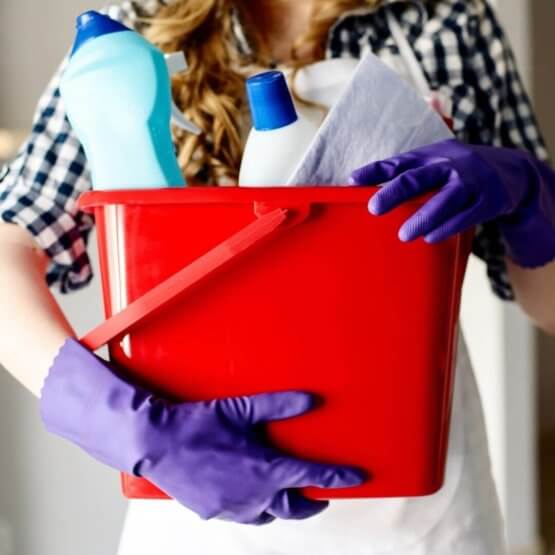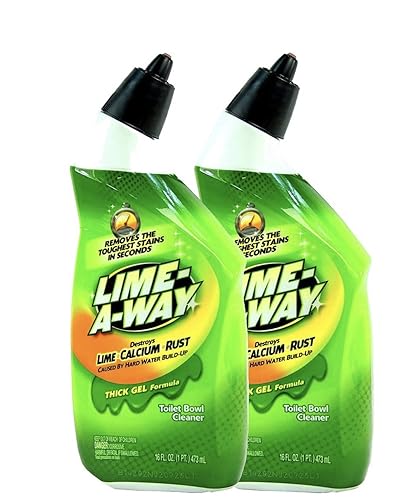Could you really use hydrochloric acid to clean toilet bowl?
Hydrochloric acid, also known as muriatic acid or hydronium chloride, is a component of several toilet bowl cleaners because of its corrosive ability to remove stubborn stains. The amount of hydrochloric acid in a toilet bowl cleaner can vary from 7% to 40%, depending on the manufacturer.
You deserve to have a spotless toilet. And the only way to keep it that way is to ensure you have the tools to remove dirt and stains.
Can You Use Hydrochloric Acid To Clean Toilet Bowl?

Because it effectively eliminates filth and dirt, hydrochloric acid aids in toilet bowl cleaning and leaves your toilet stain-free. While vinegar can get rid of brown stains, you’ll need to think about using hydrochloric acid if the issue persists.
However, due to its strength, hydrochloric acid is a highly corrosive substance that may burn skin, etch stone, dissolve metal, and even remove enamel. Therefore, to protect your toilet and drainpipes, you must handle it cautiously and refrain from using it frequently. [1] [2]
How to Handle Hydrochloric Acid Safely
You must handle hydrochloric acid carefully since it is a strong chemical that can harm your eyes, skin, bathroom floor, and anything else it touches. Here are the safety measures you should observe if you clean the toilet bowl with hydrochloric acid.
- Use protective equipment
Put on chemical splash goggles, chemical-resistant gloves, and a chemical-resistant apron before handling hydrochloric acid to protect your skin and eyes. Additionally, breathing in the vapors of this acid might cause respiratory problems, especially if you have asthma, so wear a mask to prevent this [3].
- Maintain Ventilation in Your Bathroom
You don’t want hydrochloric acid vapors concentrated in your bathroom since they can hurt your respiratory system. So, before using the chemical to clean your toilet bowl, turn on the bathroom fan.
- Remove any spills Immediately.
You don’t want the hydrochloric acid you spilled to remain on your bathroom floor or any other surface for an extended period because that could lead to corrosion. As a result, tidy up the mess right away to safeguard your home.
If the stain is recent or fresh, generously sprinkle baking soda over it. If the stain is much older, make a thick paste using baking soda and water. Then apply the paste to the entire discoloration. After doing this, let it a few minutes to settle before wiping it with a cloth.
- Adhere To The Manufacturer’s Guidelines
You can discover the manufacturer’s instructions for handling the chemical on the hydrochloric acid bottle. To ensure your safety and to prevent harm, be careful to adhere to them precisely.
- Keep Acid Well Stored
Make sure your kids can’t access the hydrochloric acid by keeping it in a separate wooden cabinet. You should avoid a metallic cabinet since hydrochloric acid fumes damage metals. Label your acid bottles as well to prevent confusion.
- Handling Exposure to Hydrochloric Acid
If hydrochloric acid touches your eyes or skin, seek medical help immediately. First, rinse the area for 15 to 20 minutes with clean water if your skin has been exposed to acid. You should rinse for at least 15 to 20 minutes if it gets into your eyes. In addition, take off your clothes if acid spills on them to prevent it from getting on your skin [5].
How long to leave hydrochloric acid in the toilet?
Slowly pour a solution of one part hydrochloric acid into five parts water into the toilet bowl. Enough water should be added to the bowl to reach the normal level. Any additional materials will be flushed down the drain toward your septic tank if you add any.
Give the acid solution up to two hours to work. Always put the toilet lid down if you have to leave the room to stop animals from consuming the acid solution. Never leave the toilet unattended if there are kids in the house. Complete the task as soon as possible.[6]
The Best Toilet Bowl Cleaners with Hydrochloric Acid
Products for cleaning toilet bowls can either be general cleansers with higher acid content or calcium, rust, and lime removers with a lower hydrochloric acid concentration. Here are some fantastic choices for hydrochloric acid-based toilet bowl cleaners.
- Lysol Power Toilet Bowl Cleaner
This cleaner has many helpful features and works well for daily tasks. It is made to remove stubborn stains, leaves your toilet incredibly clean because it is a disinfectant, and its lovely scent will leave your bathroom feeling wonderful.
In addition to being safe for your septic and plumbing systems, Lysol power toilet bowl cleaning excels at removing rings from your toilet bowl. Additionally, it retains its scent, is inexpensive, simple to use, and may be used to scrub away stains.
Lime-A-Way Toilet Bowl Cleaner
- Brand: Reckitt Bencekiser
- Type of Cleaner: Toilet Bowl
- Form: Gel
This gentle toilet bowl cleaning is ideal for daily use and safe for your plumbing system. Even those stuck below the waterline, rust, calcium, and lime can be easily destroyed by it.
The toilet bowl cleaner will remove even the toughest stains, leaving your toilet sparkling, clean, and smelling fresh. Compared to other cleaning solutions, some customers think Lime-A-Way toilet bowl cleanser is denser. If you need to clean your toilet bowl thoroughly, think about using this cleanser.
Zep Acidic Toilet Bowl Cleaner
No products found.
Consider Zep acidic toilet bowl cleanser, a gel formulation with 10% acid, if you’re looking for a toilet cleaner ideal for urinals and toilets. It has an angled neck that makes applying cleaner under the rim simple.
Because it is a thick gel, it will easily adhere to vertical surfaces. It also effectively removes calcium deposits and rust and leaves a pleasant fresh smell behind. However, avoid using it to clean enameled surfaces, floors, worktops, sinks, or bathtubs.
Read Also: Does CLR Remove Brown Stains
Toilet Cleaner Acid Side Effects

Lung damage can result from using the acid that is so frequently used to clean toilets. Nearly 91 percent of doctors associate respiratory and other health issues with toilet cleaning acids [10].
Even a brief exposure to acid fumes can cause major respiratory issues like bronchitis and asthma, nasal ulcers, pulmonary edema, and other complications like kidney damage, bluish fingernails, lips, etc.
Toilet Cleaner Poisoning
Synthetic, commercially available cleaning agents are used to clean toilet bowls. However, when combined with water, the compounds are caustic and may emit unpleasant vapors or smells.
Accidentally or deliberately consuming any chemical substance results in poisoning. The exposure might occur after ingesting the chemical, through the skin or ocular contact, or both [11].
The clinical history, the mix of symptoms, and additional testing (which, in certain situations, may include radiological examinations and laboratory tests) are used to make the diagnosis.
Causes of Toilet Cleaner Poisoning
When toilet bowl cleaner is consumed, it might result in toilet cleaner poisoning (liquid). Additional exposure routes include direct skin or eye contact.
This intake may be unintentional or, in rare situations, purposeful to cause self-harm. In addition, respiratory issues may result from breathing in the vapors of the toilet bowl cleanser.
These liquids may contain dangerous and caustic substances such as hydrochloric acid, carbolic acid, isopropyl alcohol, sodium bisulfate, ammonium chloride, di-chlorobenzene, and others.
Other prescription or over-the-counter drugs in the body may interact with the substance. Unwanted side effects may emerge from such interactions, which may increase the therapeutic effects of other medications.
Symptoms of Toilet Cleaner Poisoning
Toilet cleaner poisoning can cause various indications and symptoms, depending on the individual. It could be minor for some people and severe for others. The digestive, respiratory, circulatory, neurological, urinary, skin, and ENT systems, as well as other physiological systems, may all be impacted [12].
Ingestion of toilet cleaners may cause the following indications and symptoms:
- Excruciating heat and discomfort in the mouth, throat, and food pipe; may also impact the eyes, nose, and ears
- Serious burns and rashes on the skin (perforations on the skin may be observed)
- Breathing issues, which could get worse if the chemical is ingested; wheezing
- Headache
- Bloody stools; nausea; vomiting (blood may be observed in the vomit);
- Potentially very uncomfortable and cramping stomach and abdominal pain
- Vision loss,
- Sudden drops in blood pressure (hypotension),
- Seizures,
- Severe blood pH changes that impact numerous body parts and organs,
- Collapse and coma
Read Also: Is Drain Cleaner Acid or Base
Conclusion
By dissolving hard-to-remove stains, calcium, lime, rust, and other substances from your toilet bowl, hydrochloric acid will assist in transforming your porcelain throne. But while working with this substance, safety must always come first. Follow the safety instructions.
Along with the previously listed items, the market also sells a variety of toilet cleaning products that contain hydrochloric acid. Only the one that best suits you needs to be chosen.
Read Next: Muriatic Acid For Toilet Cleaning

Michael Davis is a heating & plumbing expert who currently works as independent contractor in SC. He also writes for Plumbertip.
For almost 10 years he worked on various plumbing tasks across South Carolina.




